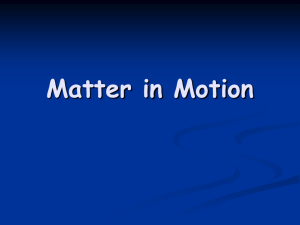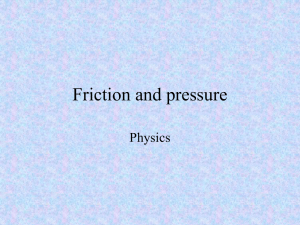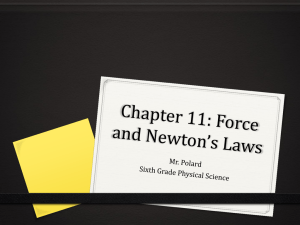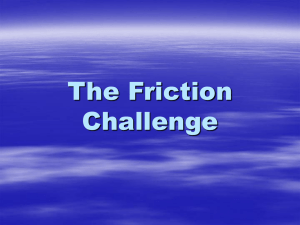PHY 105 (Module 2) March 30 * April 13, 5 hours
advertisement
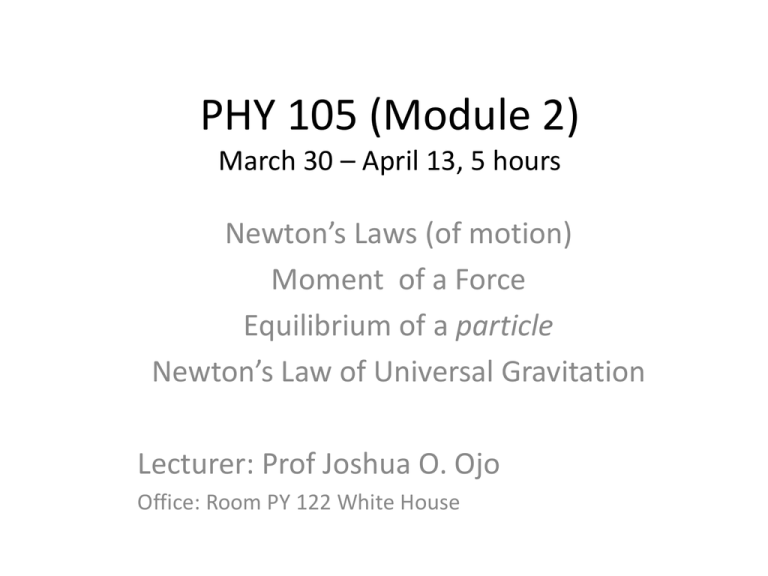
PHY 105 (Module 2) March 30 – April 13, 5 hours Newton’s Laws (of motion) Moment of a Force Equilibrium of a particle Newton’s Law of Universal Gravitation Lecturer: Prof Joshua O. Ojo Office: Room PY 122 White House Now, your study of Physics begins! • All you’ve learnt so far are very important tools to enable us discuss Physics. But you might as well have learnt those in a Maths class. • Physics deals with the study of the physical universe with the objective of finding how things work – the Laws behind it all. (Note: we assume there are laws, and we try to state these empirically) Newton’s Laws (of motion) -named after Sir Isaac Newton, British scientist. • The first suite of Laws we’ll be studying deals with motion. From the motion of a rocket headed for the moon to that of blood flowing in your capillaries. • As is true for most topics in Physics, they are really easy-to-grasp and “common-sensical” • 90% of the rest of this Course is essentially the application of what you’ll be learning today. So better pay close attention! Newton’s 1st Law An object continues in a state of rest or of uniform motion along a straight line unless a net force acts on it • Frequently called the law of inertial, this law essentially introduces the very important physical quantities: Force and Inertial mass. It says: • 1. A body at rest will continue to be at rest except there is a net force acting on it. • 2. A body in uniform motion will continue with its uniform motion unless there is a net force acting on it. (Uniform motion => No change in either magnitude or direction of the velocity vector. Obviously Statement 1 is just a special case of Statement 2). Summary: Inertial (mass) makes a physical object reluctant to welcome changes. Net Force compels it ! Poser: How about timed bombs? Practical Illustrations Use of safety belts. Here car stopped by the wall. Net force compels motion of car to change However, driver (when not restrained to the car by safety belt) is not affected by the force provided by the wall. He continues in his motion along a straight line! Further illustrations below. Later on in this and other modules, we’ll consider cases where change in motion is essentially that of change in direction. The nature of Force can be gravitational (this module), electric, magnetic, nuclear weak and strong – PHY !06 Newton’s 2nd Law the rate of change of momentum is directly proportional to the net force • This gives us an empirical/operational definition of “Force”. (Most of the calculations you will be doing in Physics is based directly on this empirical definition we are about to describe) • The 2nd Law of motion introduces to us the vector quantity Momentum. 2nd Law the rate of change of momentum is directly proportional to the net force • It means the more the applied/net force, the greater the rate of change of momentum • Momentum is the product of Mass and Velocity • Questions: What is the momentum of an object of • i. mass 50 kg moving with a velocity of 100 m/s? • ii. Mass = 1000 kg, v = 0.001 cm/s? • Iii. Mass = 10 g, v = 1,0000 m/s? 2nd Law • • • • • the rate of change of momentum is directly proportional to the net force It means the more the applied/net force, the greater the rate of change of momentum Change of Momentum means: Momentum after the application of the net force less Momentum before the application of the Force i.e. (Final Mass x Final velocity) – (Initial Mass x Initial velocity) Example: i. What is the momentum of a tipper (mass 3,000 kg) when loaded with 2,000 kg of sand if it is moving with a uniform velocity of 10 m/s? Ii. What is the momentum of the same tipper if it moves with the same velocity after discharging its load? [Units?] 2nd Law the rate of change of momentum is directly proportional to the net force • What is rate of change? • It means how long did it take to effect the change. • Example: If momentum of a car changes uniformly from 2500 kgms-1 to 1500 kgms-1 in 10 s, what is the rate of change of momentum? • Ii. What is this rate if the time involved were 20s? 2nd Law the rate of change of momentum is directly proportional to the net force • Summary of the 2nd Law: • For momentum to change, something called force must be involved (a more general statement of the 1st law). • The larger the force involved, the greater the rate of change of momentum • Mathematically, 2nd Law the rate of change of momentum is directly proportional to the net force • If we choose appropriate unit system, we can equate the constant of proportionality to 1, hence we can write F = ma This famous equation you will use repeatedly in your study of Physics. But remember, it is only a special form of the 2nd Law of motion, WHEN THE MASS IS NOT CHANGING. For instance in the rocket problem, mass is not constant. (Neither for a running athlete – sweating, exhaling etc implies loss of water, not to talk of fat burned off!) Assignment Calculate the Forces involved for various values of masses, velocities and times. Note unit of Force is Kgms-2 which in SI Unit is Newton (N) • Last class, we found an operational way of quantifying force. • The Home work was for you to play with different values of the different related physical quantities. Values of force can affect values of mass, velocity, or time of the process. • Before we take more critical look at: • types of forces: Tensile force, compressive force, friction, Air resistance force, Normal force, weight, etc; • Nature of Forces: Contact, gravitational, electromagnetic, nuclear • And derivative quantities: work,energy, power, action, impulse, moment, torque, etc • let’s consider the 3rd Law. Newton’s 3rd Law of motion To every action (force), there is an equal and opposite reaction (force) • Forces always exist in pairs. Whenever there is an interaction between two objects, there is a force upon each of the objects. When the interaction ceases, the two objects no longer experience the force [motion then continues uniformly from that point on]. Forces only exist as a result of an interaction • When an object exerts a force (the action force) on a second object, the second object also in turn exerts a reaction force on the first object. • When two bodies interact, the forces on the bodies from each other, are always equal (magnitude) and in opposite directions. Newton’s 3rd Law of motion To every action (force), there is an equal and opposite reaction (force) • Some every-day examples: • Birds flapping wings to soar. Upthrust. • Fishes push water with fins for forward propulsion (same with canoes, etc) • Cars push back the road to move forward. (consider car without grip on the road – eg, smooth/muddy road or threadless tire, or jacked-up car!) Newton’s 3rd Law of motion To every action (force), there is an equal and opposite reaction (force) • One major implication of the third law is the very important law of conservative of momentum. • Both Action Force and the Reaction Force produces changes of momentum in the two interacting bodies. • Since the two forces are equal and opposite, and act over exactly the same time period, equal changes in momenta are produced in the two different bodies. • The relative masses of the bodies will therefore determine what relative velocities they get Newton’s 3rd Law of motion To every action (force), there is an equal and opposite reaction (force) • Examples: • See, the car moves backward after the impact. The Wall also moves backward, even if imperceptibly in this case • Recoil of a gun during shooting • Remember, it’s momentum (product of mass and velocity) that is conserved. The greater mass has the less velocity after the interaction Some particular forces • A Gravitational Force Fg on a body is a pull by another body. In most situations that we shall be dealing with in this course, the other body is the Earth (or some other astronomical body). Here, • the force is directed down toward the centre of the earth, and has • magnitude Fg = mg, [From F = ma] • where g here is the acceleration due to gravity (more on this later) Some particular forces…. • Weight W of a body is the magnitude of the upward force needed to balance the gravitational force on the body due to Earth (or some other astronomical body). It is related to the body’s mass by • W= mg Some particular forces…… • Frictional Force • Is the force on a body when the body slides or attempts to slide along a surface. The force is always parallel to the surface and directed so as to oppose the motion of the body. On a frictionless surface, the frictional force is negligible. • When a body moves through air, friction is termed air-resistance. In fluid, friction is reflected as viscosity. Illustration of Gravitation Force, Weight, Air resistance/Friction g is the same, but with air resistance net force is reduced. More later….. See text: 6-4 Normal Force... • Normal Force N is the force on a body from a surface against which the body presses. The normal force is always perpendicular (Normal) to the surface • Illustrate j N F ma fF mg i Tension • Tension: When a cord is under tension, it pulls on a body at each of its ends. The pull is directed along the cord, away from the point of attachment to each body. For a massless cord (a cord with negligible mass), the pulls at both ends of the cord have the same magnitude T, even if the cord runs around a massless, frictionless pulley (a pulley with negligible mass and negligible friction on its axle to oppose its rotation). Applying Newton’s Laws to solve various problems. • Navigate to Answers for: • Questions #1-7 Questions #8-#36 Questions #37-#46 Questions #47-#60 Examples for Discussion • 8a. Orobo has a mass of 100 kg on the earth. What is Orobo's mass on the moon where the force of gravity is approximately 1/6-th that of Earth's? ________ Explain or show your work. • 8b. Sis Lepa weighs 360 N on Earth. What is Sis Lepa's mass on the moon where the force of gravity is approximately 1/6-th that of Earth's? ________ Explain or show your work. • 9. TRUE or FALSE: • An object which is moving rightward has a rightward force acting upon it. • 10. The amount of net force required to keep a 5-kg object moving rightward with a constant velocity of 2 m/s is ____. • a. 0 N • b. 0.4 N • c. 2 N • d. 2.5 N • e. 5 N Examples for Discussion • 12. Which one(s) of the following force diagrams depict an object moving to the right with a constant speed? List all that apply. • . Examples for Discussion • 13. According to Newton's third law, every force is accompanied by an equal and opposite reaction force. The reason that these forces do not cancel each other is ____. • a. the action force acts for a longer time period • b. the two forces are not always in the same direction • c. one of the two forces is greater than the other • d. the two forces act upon different objects; only forces on the same object can balance each other. • e. ... nonsense! They do cancel each other. Objects accelerate because of the presence of a third force Examples for Discussion • 48. A 72-kg skydiver is falling from 5000 m. At an instant during the fall, the skydiver encounters an air resistance force of 540 Newtons. Determine the acceleration of the skydiver at this instant. PSYW • 50. A 5.20-N force is applied to a 1.05-kg object to accelerate it rightwards across a friction-free surface. Determine the acceleration of the object. (Neglect air resistance.)PSYW • 52. Determine the applied force required to accelerate a 3.25-kg object rightward with a constant acceleration of 1.20 m/s/s if the force of friction opposing the motion is 18.2 N. (Neglect air resistance.) Examples for Discussion A 921-kg sports car is moving rightward with a speed of 29.0 m/s. The driver suddenly slams on the brakes and the car skids to a stop over the course of 3.20 seconds with the wheels locked. Determine the average resistive force acting upon the car. [F = d(mv)/dt] A 1250-kg small aircraft decelerates along the runway from 36.6 m/s to 6.80 m/s in 5.10 seconds. Determine the average resistive force acting upon the plane. (Assume that its engine/propeller makes no contributes to its forward motion). [F = d(mv)/dt] A tow truck exerts a 18300-N force upon a 1210 car to drag it out of a mud puddle onto the shoulder of a road. A 17900 N force opposes the car's motion. The plane of motion of the car is horizontal. Determine the time required to drag the car a distance of 6.90 meters from its rest position. [F = d(mv)/dt; v2=u2+2ax; v-u+at] Examples for Discussion A 4.44-kg bucket suspended by a rope is accelerated upwards from an initial rest position. If the tension in the rope is a constant value of 83.1 Newtons, then determine the speed (in m/s) of the bucket after 1.59 seconds. v=u+at A 22.6-N horizontal force is applied to a 0.0710-kg hockey puck to accelerate it across the ice from an initial rest position. Ignore friction and determine the final speed (in m/s) of the puck after being pushed for a time of .0721 seconds. [F = d(mv)/dt] A train has a mass of 6.32x104 kg and is moving with a speed of 94.3 km/hr. The engineer applies the brakes which results in a net backward force of 2.43x105Newtons on the train. The brakes are held for 3.40 seconds. How far (in meters) does the train travel during this time? More on Friction, Normal reaction, Gravitation (lesson 3) • We want to look a little more closely at some of the very important Forces we come across in using F = ma. • friction - resistance encountered by an object as it interacts with its surroundings • o static friction - when friction stops an object from moving, static friction opposite & equal to the force being exerted on the object • Fs ≤ µsN (where the dimensionless constant µs is called the coefficient of static friction ) • And N is the Normal Reaction. More on Friction • See, the Frictional force depends on the Normal Reaction • Force of friction acts to oppose motion: – Parallel to surface. – Perpendicular to Normal force. – Since fF = mN , the force of friction does not depend on the area of the surfaces in contact j N F i ma = 0 fF mg See text: 5-2 Static Friction... • mS is discovered by increasing F until the block starts to slide: i: j: FMAX - mSN = 0 N = mg mS = FMAX / mg N FMAX mSmg j i mg Magnitude of force of Friction depends on Normal reaction More on Friction • kinetic friction - friction force for an object in motion • Fk = µkN µk - dimensionless constant called the coefficient of kinetic friction –. j N F ma Fk See figure 5-11 mg i Coeff. Of static friction µs increases to a max. µk is smaller than µs See text: 6-4 Coeff. Of static friction µs increases to a max. µk is smaller than µs • Graph of Frictional force vs Applied force: fF = mSN fF = mKN fF fF = FA FA See text: 6-4 Problem: Box on Truck • A box with mass m sits in the back of a truck. The static coefficient of friction between box and truck is mS – What is the maximum acceleration a that the truck can have without the box slipping? m a mS N See text: 6-4 Problem: Box on Truck • Draw Free Body Diagram for box: – Consider case where fF is max... (i.e. if the acceleration were any larger, the box would slip). N j i f F = m SN mg See text: 6-4 Problem: Box on Truck • Use FTOT = ma for both i and j components –i –j mSN = maMAX N = mg N aMAX = mS g j aMAX i f F = m SN mg See text: 6-4 Problem: Putting on the brakes • Anti-lock brakes work by regulating making sure the wheels roll without slipping. This maximizes the frictional force slowing the car since mS > mK . • The driver of a car moving with speed vo slams on the brakes. The coefficient of static friction between wheels and the road is mS . What is the stopping distance D? ab See example Stopping a car vo v=0 D See text: 6-4 Problem: Putting on the brakes D = v0 t - 1/2 abt2 0 = v0 - abt In our problem: v 02 D= 2 ab Solving for D: v 02 D= 2 ms g Putting in ab = mSg (F=ma=mg=umg) ab vo v=0 D See example : Stopping a car => t=vo/a Incline planes…. Fgrav acts vertically downwards Fnorm acts normally from the plane Ffric acts parallel to the plane Here, we replace the force of gravity by two components. Then solve for the net force and acceleration the usual way • Example • A 100-kg crate is sliding down an inclined plane. • The plane is inclined at an angle of 30o • The coefficient of friction between the crate and the incline is 0.3. • Determine the net force and acceleration of the crate. • First, find the force of gravity acting upon the crate and the components of this force parallel and perpendicular to the incline. • The force of gravity is 980 N (mg) • Fparallel = 490 N (980 N • sin 30 degrees) and • Fperpendicular = 849 N (980 N • cos30 degrees). • Example • A 100-kg crate is sliding down an inclined plane. • The plane is inclined at an angle of 30o • The coefficient of friction between the crate and the incline is 0.3. • Determine the net force and acceleration of the crate. • Now the normal force can be determined to be 849 N (it must balance the perpendicular component of the weight vector). • The force of friction can be determined from the value of the normal force and the coefficient of friction; Ffrict is 255 N (Ffrict = "mu"*Fnorm= 0.3 • 849 N). • Example • A 100-kg crate is sliding down an inclined plane. • The plane is inclined at an angle of 30o • The coefficient of friction between the crate and the incline is 0.3. • Determine the net force and acceleration of the crate. • The net force is the vector sum of all the forces. The forces directed perpendicular to the incline balance; the forces directed parallel to the incline do not balance. • The net force is 235 N (490 N - 255 N). • The acceleration is 2.35 m/s/s (Fnet/m = 235 N/100 kg). see, we can repeat the last problem, substituting ‘car’ for ‘crate.’ It’s exactly the same problem. Gravitation LAW OF UNIVERSAL GRAVITATION • NEWTON’S Every particle in the Universe attracts every other particle • with a force that is proportional to the product of their masses and inversely proportional to the square of the distance between them. [Irrespective of intervening medium] • • Where G = 6.673 x 10-11 N.m2/kg2 (a very weak force!) Example: Tolu, Tunde, Titi and Tope are located at the four corners of a square auditorium (length 15m). If each of these students has a mass of 60 kg, what is the net gravitational force on one of them due to the other 3? • F1=F12+F13+F14 R12 R14 • R13 2 = R12 2 + R14 2 Moment (Torque) of a Force • Several derivatives of Force are used in Physics: eg Work /Energy (Force and distance moved by force) • Power (Work/Time) • Impulse (Force * Time) • Moment (Force and distance from a fulcrum/axis) • etc The Torque is measure of the tendency of a force to rotate an object about some axis. It is a vector quantity τ = F x d The turning effect, when only the perpendicular distance between the Force and the turning axis is used, is called Moment Moment = Force X perpendicular distance from the turning point/axis examples F2 d1 F1 d2 Conditions for Equilibrium 1. No net force • Sum of forces along x axis = 0 (ΣFx = 0) Sum of forces along y axis = 0. (ΣFy = 0) [Sum of forces along z axis = 0. (ΣFz = 0)] 2. No net moment 3. Please check textbooks for several examples. Homework: The leg and cast in the figure weigh 220N (w1). Determine the weight w2 and the angle α needed so that no force is exerted on the hip joint by the leg plus cast. (note, if all the forces did not act on the same point as in this case, there would be turning effects also to consider). Homework: Two packing crates of masses 10.0 kg and 5.00 kg are connected by a light string that passes over a frictionless pulley as in the figure. The 5.00 kg crate lies on a smooth incline of angle 40.0o. Find the acceleration of the 5.00 kg crate and the tension in the string. END OF MODULE 2 THANK YOU FOR YOUR ATTENTION Tutorial Questions and e-copies of these teaching slides will be made available on the internet for FREE download or at the FREE Tutorial Classes being arranged by the Physics Department. Details will be provided by the Course Secretary/Teaching Assistants. WISHING YOU ALL THE BEST!



